|
Sandro Botticelli.org, welcome & enjoy!

|
|
Here are all the paintings of Courbet, Gustave 01
| ID |
Painting |
Oil Pantings, Sorted from A to Z |
Painting Description |
| 18954 |
 |
A Burial at Ornans |
1849-50
Oil on canvas
Mus??e d\'Orsay, Paris. |
| 65891 |
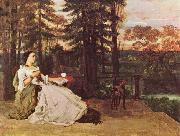 |
Dame auf der Terrasse (Le dame de Francfort) |
1858
Oil on canvas
207 x 325 cm (81.50 x 127.95 in) |
| 86071 |
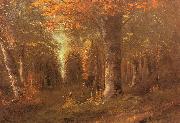 |
Forest in Autumn |
21.26 inch wide x 14.96 inch high
Date 1841(1841)
cyf |
| 32546 |
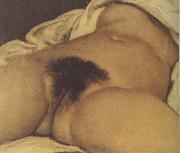 |
L'Origine du monde |
mk79
1866
Paris
|
| 31068 |
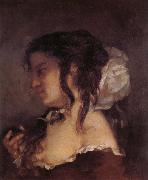 |
La Reflexion |
mk71
Toile
H.0.54
L.0.45
Douai,Musee de la Chartreuse
|
| 74005 |
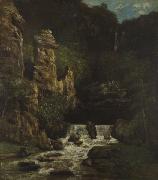 |
Landscape with Waterfall |
oil on canvas, by the French artist Gustave Courbet. 43 in. x 38 3/4 in. x 2 1/2 in. Yale University Art Gallery, gift of Walter Bareiss, B.S. 1940s. Courtesy of Yale University, New Haven, Conn.
Date circa 1865
cyf |
| 18960 |
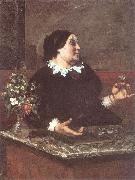 |
Mere Gregoire |
1855
Oil on canvas
The Art Institute of Chicago. |
| 32543 |
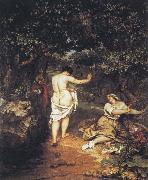 |
Recreation by our Gallery |
mk79
1853
|
| 32570 |
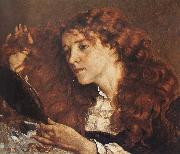 |
Recreation by our Gallery |
mk79
1866
|
| 32600 |
 |
Recreation by our Gallery |
mk79
1865-1866
|
| 18952 |
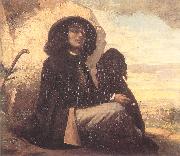 |
Self-Portrait (Courbet with a Black Dog) |
1844 (Signed 1842)
Oil on canvas
Mus??e du Petit Palais, Paris. |
| 18951 |
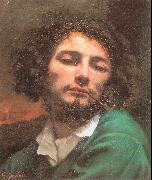 |
Self-Portrait (Man with a Pipe) |
1848-49
Oil on canvas
Mus??e Fabre, Montpellier. |
| 33849 |
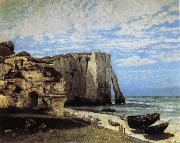 |
The Cliff at Etretat after the Storm |
mk87
1870
Oil on canvas
133x162cm
Paris,Musee d'Orsay
|
| 18949 |
 |
The Desperate Man |
1843-44
Oil on paper mounted on canvas
Nationalgalerie, Oslo. |
| 18963 |
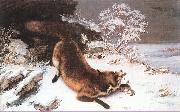 |
The Fox in the Snow |
1860
Oil on canvas
The Dallas Museum of Art. |
| 18950 |
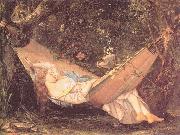 |
The Hammock |
1844
Oil on canvas
Oskar Reinhart Foundation, Winterthur. |
| 18957 |
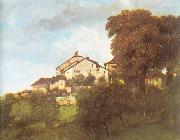 |
The Houses of the Chateau D Ornans |
1853
Oil on canvas
Private collection, Switzerland. |
| 18958 |
 |
The Meeting (Bonjour, Monsieur Courbet) |
1854
Oil on canvas
Mus??e Fabre, Montpellier. |
| 18959 |
 |
The Painter s Studio |
1854-55
Oil on canvas
Mus??e d\\\\\\\'Orsay, Paris. |
| 18953 |
 |
The Peasants of Flagey Returning from the Fair |
Ornans
1850-55
Oil on canvas
Mus??e des Beaux-Arts, Besançon. |
| 18962 |
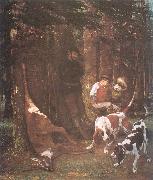 |
The Quarry |
1857
Oil on canvas
Museum of Fine Arts, Boston. |
| 54525 |
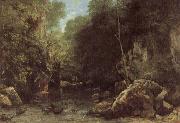 |
The Shaded stream |
mk235
1865
Oil on canvas
94x135cm
|
| 18956 |
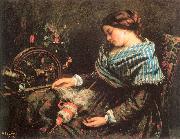 |
The Sleeping Spinner |
1853
Oil on canvas
Mus??e Fabre, Montpellier. |
| 18955 |
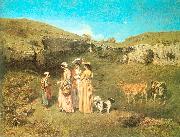 |
The Young Ladies of the Village |
1851-52
The Metropolitan Museum of Art, NY.
|
| 18961 |
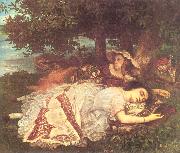 |
The Young Ladies on the Banks of the Seine (Summer) |
1856-57
Oil on canvas
Mus??e du Petit Palais, Paris. |
| 32580 |
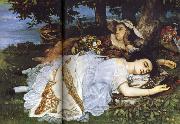 |
Young ladies at the bank of the Seine |
mk79
1857
Prais
|
|
|
| Courbet, Gustave
|
| French Realist Painter, 1819-1877
Gustave Courbet was born at Ornans on June 10, 1819. He appears to have inherited his vigorous temperament from his father, a landowner and prominent personality in the Franche-Comt region. At the age of 18 Gustave went to the College Royal at Besançon. There he openly expressed his dissatisfaction with the traditional classical subjects he was obliged to study, going so far as to lead a revolt among the students. In 1838 he was enrolled as an externe and could simultaneously attend the classes of Charles Flajoulot, director of the cole des Beaux-Arts. At the college in Besançon, Courbet became fast friends with Max Buchon, whose Essais Poetiques (1839) he illustrated with four lithographs. In 1840 Courbet went to Paris to study law, but he decided to become a painter and spent much time copying in the Louvre. In 1844 his Self-Portrait with Black Dog was exhibited at the Salon. The following year he submitted five pictures; only one, Le Guitarrero, was accepted. After a complete rejection in 1847, the Liberal Jury of 1848 accepted all 10 of his entries, and the critic Champfleury, who was to become Courbet's first staunch apologist, highly praised the Walpurgis Night. Courbet achieved artistic maturity with After Dinner at Ornans, which was shown at the Salon of 1849. By 1850 the last traces of sentimentality disappeared from his work as he strove to achieve an honest imagery of the lives of simple people, but the monumentality of the concept in conjunction with the rustic subject matter proved to be widely unacceptable. At this time the notion of Courbet's "vulgarity" became current as the press began to lampoon his pictures and criticize his penchant for the ugly. His nine entries in the Salon of 1850 included the Portrait of Berlioz, the Man with the Pipe, the Return from the Fair, the Stone Breakers, and, largest of all, the Burial at Ornans, which contains over 40 life-size figures whose rugged features and static poses are reinforced by the somber landscape. A decade later Courbet wrote: "The basis of realism is the negation of the ideal. Burial at Ornans was in reality the burial of romanticism." In 1851 the Second Empire was officially proclaimed, and during the next 20 years Courbet remained an uncompromising opponent of Emperor Napoleon III. At the Salon of 1853, where the painter exhibited three works, the Emperor pronounced one of them, The Bathers, obscene; nevertheless, it was purchased by a Montpellier innkeeper, Alfred Bruyas, who became the artist's patron and host. While visiting Bruyas in 1854 Courbet painted his first seascapes. Among them is the Seashore at Palavas, in which the artist is seen waving his hat at the great expanse of water. In a letter to Jules Vall's written in this period Courbet remarked: "Oh sea! Your voice is tremendous, but it will never succeed in drowning out the voice of Fame shouting my name to the entire world." Courbet was handsome and flamboyant, naively boastful, and aware of his own worth. His extraordinary selfconfidence is also evident in another painting of 1854, The Meeting, in which Courbet, stick in hand, approaches Bruyas and his servant, who welcome him with reverential attitudes. It has recently been shown that the picture bears a relationship to the theme of the Wandering Jew as it was commonly represented in the naive imagery of the popular Épinal prints. Of the 14 paintings Courbet submitted to the Paris World Exhibition of 1855, 3 major ones were rejected. In retaliation, he showed 40 of his pictures at a private pavilion he erected opposite the official one. In the preface to his catalog Courbet expressed his intention "to be able to represent the customs, the ideas, the appearance of my own era according to my own valuation; to be not only a painter but a man as well; in short, to create living art." One of the rejected works was the enormous painting The Studio, the full title of which was Real Allegory, Representing a Phase of Seven Years of My Life as a Painter. The work is charged with a symbolism which, in spite of obvious elements, remains obscure. At the center, between the two worlds expressed by the inhabitants of the left and right sides of the picture, is Courbet painting a landscape while a nude looks over his shoulder and a child admires his work. Champfleury found the notion of a "real allegory" ridiculous and concluded that Courbet had lost the conviction and simplicity of the earlier works. Young Ladies by the Seine (1856) only served to further convince the critic of Courbet's diminished powers. But if Courbet had begun to disappoint the members of the old realist circle, his popular reputation, particularly outside France, was growing. He visited Frankfurt in 1858-1859, where he took part in elaborate hunting parties and painted a number of scenes based on direct observation. His Stag Drinking was exhibited in Besançon, where Courbet won a medal, and in 1861 his work, as well as a lecture on his artistic principles, met with great success in Antwerp. With the support of the critic Jules Castagnary, Courbet opened a school where students dissatisfied with the training at the cole des Beaux-Arts could hear him extol the virtues of independence from authority and dedication to nature.
|
|
 All the Sandro Botticelli's Oil Paintings
All the Sandro Botticelli's Oil Paintings

Supported by oil paintings and picture frames

Copyright Reserved
|

